This article below I have in my personal collection, however it is in such condition that I could hardly make out the text but the photos below were in good enough condition for me to restore the detail thank goodness. My good chow history friend Dennis Tang in Hong Kong, sent me a link yesterday to a transcript of the article online. I am very grateful to have this treasure to post on ChowTales for all to read. Some of the words translated kind of strangely so I’m still working on that, but I’m sure you get the general idea. Thank you Dennis!!!
From House and Garden October 1914
THE CHOW-CHOW A FUR-COATED COATED COBBY FELLOW WHO WON FAME WITHOUT A BOOM-ONCE A CHOW ALWAYS A CHOW-HIS MYSTERY
BY WILLIAMS HAYNES
IT was just about eight years ago when I was first introduced to that suave, dignified, self-contained gentleman from China, the chow-chow. In those days one did not run into him very often about, town. To be sure, he did turn up occasionally at the bench “” shows, but even in the very doggy set there were only a few who knew him well enough to speak to him. He had but recently visited this country, and though he bore capital letters of introduction from some English friends with whom he had stopped on his travels from the Far East, still he was never the sort to push himself forward. Since that time, however, he has He carries his head high, not a
Author of “Doggy Great Britain,” “Practical Dog Keeping ” was a chow when our own ancestors lived in a cave and hunted with a stone axe.
When you first meet a chow ” I remember it was so with me when I was presented to Patoo ” you may not be very favorably impressed. The dog’s wolfish appearance, his obvious strength, and his famous scowl are forbidding. Moreover, he has a very disconcerting way of sniffing at your ankles and then standing off to survey you critically. His truly Chinese mind persists in regarding all men as guilty till they are proved to be innocent. Once, However, he has convinced himself that you are “all right,” he is a very different sort of a dog. On better acquaintance he proves to be a rather cky. Folks who do not know him have the idea that he is a surly, short tempered brute made a host of staunch, good American friends in all parts.
I don’t suppose there was ever a dog who worked up to the front with less fuss and racket. One does not ordinarily think of the chow-chow as a very popular dog, but nowadays no stranger would never credit him. In fact, many people who do not know him well have the idea that a chow is a surly, short tempered brute, and time and again he is summarily condemned one is at all surprised at meeting him anywhere, and the entries
at the bench shows, which are generally a pretty good practical gauge of a breed’s popularity, have several times doubled in num his stand-offish disposition and his very evident distrust of strangers. It must be confessed that sometimes he carries his bers. Certainly there never was a “boom” in chows, and for a dog with so mysterious a past they have had but very little pub-vous visitors, but with his own people he is always a very lovable licity.
Usually the arrival of a new breed is the signal for a loud blare of trumpets and a clash of cymbals ” their history, points and good if you do not know him well, you do not know him at all. Among characteristics are literally shrilled from the housetops. Not so with the chow; he slipped into our midst as quietly as if he had Chinese aloofness and becomes a jolly playfellow, thoroughly had to evade the Asiatic exclusion laws. He stood all ready to welcome us to our friends’ homes before we more than suspected sense of humor. He is bright, faithful and affectionate. A better that there was any such dog.
The very first chow I knew professionally was Champion Patoo. He had been born in England of Chinese parents and later naturalized in the United States, but in spite of all this he first, last and always a chow. In his dealings with other dogs the chow rollicking, decidedly good natured dog ” qualities with which a as such without so much as a mock-trial. This is the result of policy of eternal vigilance too far for the peace of mind of nerdog.
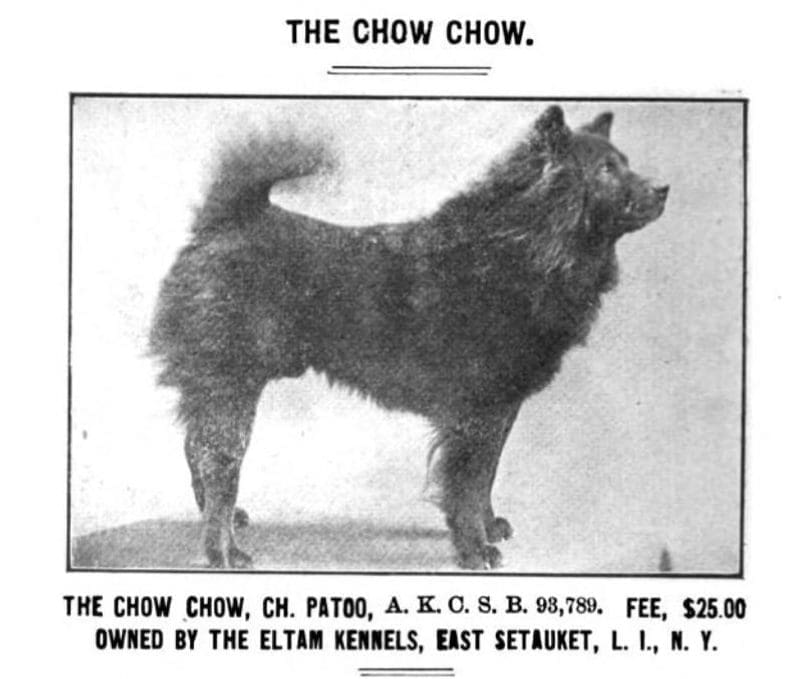
The true chow-chow is not to be known in ten minutes, and his own family and friends he casts off his suspicious air and capable of enjoying a good romp and with a remarkably keen natured dog, especially with young children, does not live. By appearance, by reputation and by nature he is a splendid watchdog, and he has courage enough and strength enough to be a ‘first, last, and all the time ” a chow. In that he was typical of adopts the hands-off motto; he bothers no dog who does not bother his race. Many dogs will reflect their environment. The chow him. His owner can rest assured that he will not be merely absorbs his and remains a chow.
Indeed, you could never mixed up in street brawls, but he had best be on his guard tell, no matter how much might depend upon it, whether a chow if he has a neighbor with a flock of prize sheep, for chow had been born on the Bowery or on Fifth Avenue. In this Mister Chow has been known to satisfy illegally his appetite he is a true Oriental, rising triumphant over our petty mushroom for mutton, civilization.
You suspect, and not without reason, that a chow Externally the chow-chow has three unique points, points that he shares with no other dogs. His coat is not hair; it is fur. His hocks, the joints in the hind leg, are not bent; they are straight. His tongue is not pink; it is blue. Any one of these very distinctive features would point to an origin distinct from that of the European breed of dogs, and since the blue tongue is unknown in any canine, wild or domesticated, this is possibly a “fancy point” developed by long and careful breeding. If so, how many, many times nimble yellow fingers must have pried open the mouths of new-born puppies and anxious almond eyes peeped in to see what degree of blueness had been attained !
The chow is a very compact A bright, up-standing, powerful dog of wolfish appearance, without the wolf’s slink dog of medium size. Heavy bone, a short back, deep, broad chest and powerful loins and quarters are all prime requisites, since a leggy, “shelly” dog is an abomination. A chow’s head is large, the skull flat, the muzzle deep and rather broad, and down the backs of the thighs, this is not desirable. The fur like coat comes in both the rough and smooth variety, but the avoiding any suggestion of the pointed, fox-like head of the pomeranian, latter has never been widely popular in America.
The ears must be small and prick, carried tilted a little forward, giving the dog the much desired scowl so typical of this dog of wolfish appearance, but without the least suggestion of or hang-dog look breed. The correct eyes are small, very bright and black in color (in the blue variety light eyes are allowed).
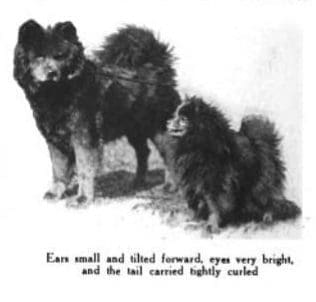
The tail must be carried tightly curled over the back. This tail carriage, so very different from the sweeping droop of the wolf and fox, has, like the blue tongue, been a puzzle that scientists and breeders have in vain tried to solve. The chow is always self-colored. Red, black and blue are all common, but cream and white are also admitted by the standard.
Personally, I think the deep, warm red is the prettiest shade. A coal black is very showy, but many black dogs are rusty looking. I have never fancied a blue; but different men: different tastes. Whatever the color, it should be solid and even, and, though many clogs are markedly lighter on the under part of the tail The chow may be summed up as a bright, up-standing, cobby A true Oriental, he absorbs his environment and remains always a chow. He has a forbidding scowl that has become famous
A compact, medium-sized dog; heavy bone, short back and deep, broad chest
Fur, not hair, is his coat ” one of the points shared with no other dog He has a disconcerting way of surveying you critically Other points proving his Asiatic origin are his straight hocks and blue tongue
History proves that the breed is no upstart, the same features that distinguish him to-day marked him over a century ago. Always a gentleman in China, he is a gentleman here the wolf’s slinking movements and hang-dog characteristics. His straight hocks give him a rolling gait, much like Jackie just ashore after a long cruise, and his high -carried head and tightlycurled tail are decidedly cocky. It may be that buried in some old Chinese manuscripts there are records of the chow, but, so far as we know, the breed is without any history. This probably accounts for the popular belief that the chow-chow is the common or garden variety of Chinese mongrel. This is not the case. Street curs there are in China beyond all numbering and many of these are wolf like animals, but they are not the real chow, who is highly regarded and generally in the hands of the mandarins or wealthy merchant s. The breed’s three distinctive points furnish evidence of great age, which is supplemented by fragmentary reports from travelers in the East. The earliest mention of the chow that I know is inrect from China. When Dr. Henry, of Philadelphia, went to San Francisco to judge the bench show, Mrs. Jarrett accompanied him and was so captivated by the odd Oriental, that she brought Daniels’ “Rural Sports,” published in London in 1801: “Mr. White describes a Chinese dog and bitch, brought fromern States. Mrs.
Canton, where they are fattened on rice meal and other farinaceous foods for the table, as being about the size of a spaniel” (in 1801 the spaniel was a much larger dog than he is to-day), “colour pale yellow, with coarse, bristling hairs on their backs, sharp, erect ears and peaked, fox-like heads. Their hind legs with no bend in the hock or ham, and so unusually straight as to cause an awkward gait in trotting. When in motion their tails are curved high over their backs and have naturally bare spots on the outside from the top half way down. Their eyes are jet black, small and piercing; inside their lips and mouth are black
Mr. Edward L. Tinker and Mrs. Van Heusen were the owners of the first kennels, and two of the early heroes of the breed were Champion Chinese Chum and Champion Patoo of the same colour, and the tongues blue.” This can surely be no other than the chow-chow, and from Chinese Chum and this passage we can gather that the same features that distinguish him to-day marked him over a century ago, fifty years before the Airedale was thought of and just about the time the bull terrier was being manufactured.
Evidently the breed is not so stand-offish an Oriental should have won admirers without advertising speaks well for his sterling qualities which are being appreciated more and more each year upstart, but we have no hint of how or when or why they had their origin. t is, of course, easy to guess that the wolf family had a hand or rather a paw, in the making of the chow, but this is pure speculation, and the curled tail and yellow eyes changed to “jet black” bob up to worry the theorist.
From this same passage we learn that the chow is esteemed as an article of diet in China. This is perfectly true, but the stories about the dog refusing to eat flesh are hardly confirmed by the very cosmopolitan appetite they display in America. Many years before the chow was introduced to this country he was common in England, but it is likely that the very first of the variety to land on our shores came to California and Mrs Proctor brought back a pair with her. So the breed was introduced into the East
An Oriental Gentleman (Continued from page 204) these dogs were English importations. In fact, most of our chows have come to us via Great Britain. Importing direct from China has been uncertain and unsatisfactory. The Mongolian dog fancier has not always proved to be a very reliable person, and, of course, breeding for type and color are quite beyond his comprehension. Some few of the Chinese importations have turned out to be nailing good specimens, but they have not been so successful in the breeding kennels.
It has been extraordinary that this quaint Chinese dog should have won its way in the United States without any spectacular booming and almost in spite of his marked unfriendliness toward strangers. Plenty of printers’ ink, a judicious boosting of prices, and a specialty club with some prominent persons among the members ” these will inflate the stock of any dog not utterly outlandish in looks and impossible in disposition, and a hail-fellow-well-met dog will always make friends.
That so dignified and reserved a gentleman as the chow should have won so many admirers without any advertising speaks for his sterling qualities. And he has been indeed fortunate in his friends: they have always been decidedly the right kind of people for a good dog to know. As one of their warmest supporters said to me the other day, “Thank the ghost of Confucius! the chow is popular, but not too blamed popular !”
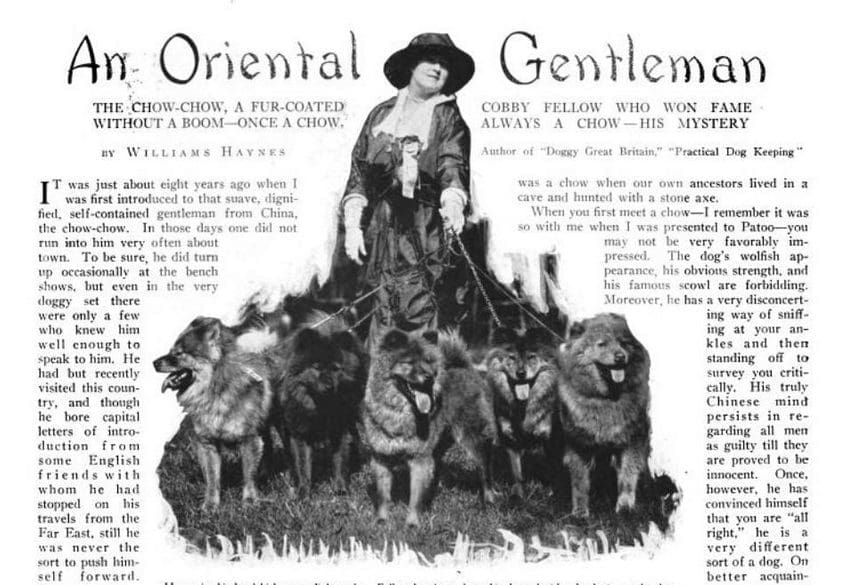
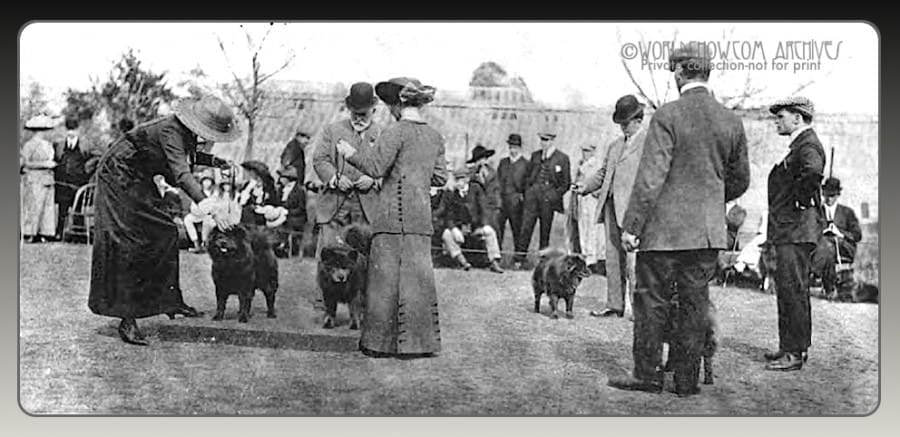



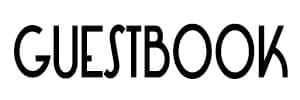
Leave a Reply